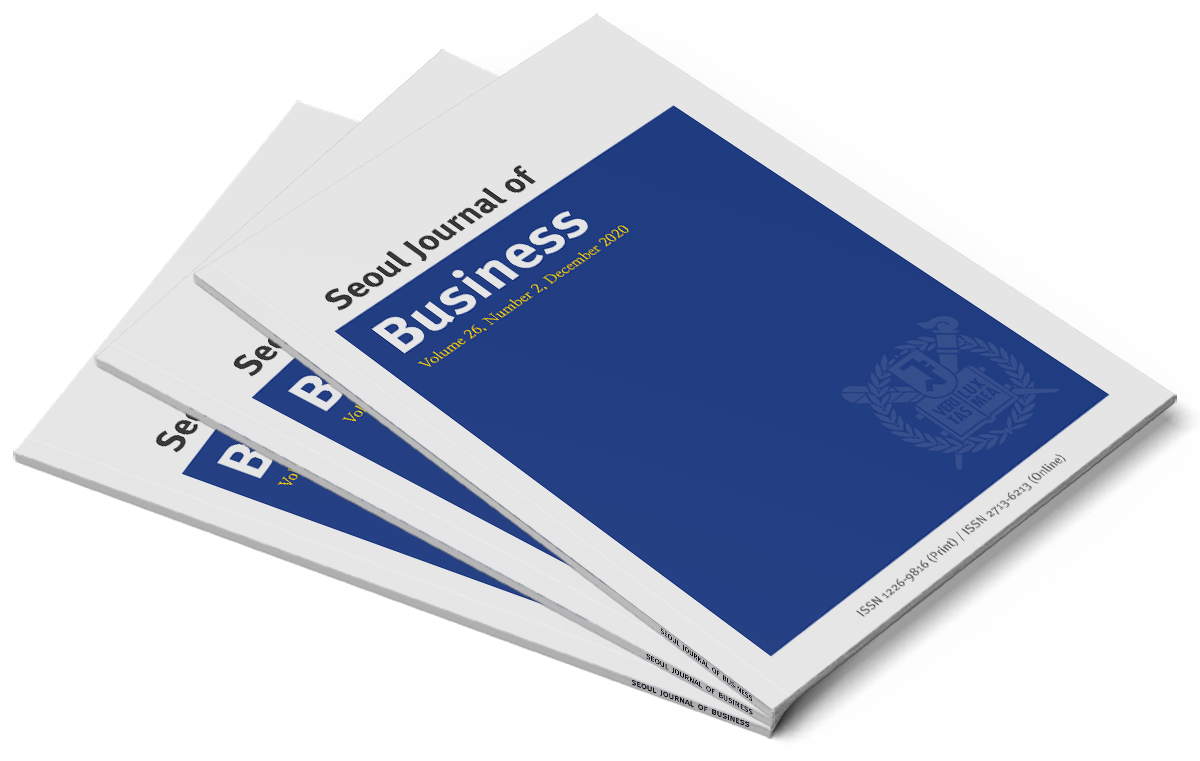Recent Issues
Vol.27/1 (2021, June)
The Effects of Procedural Justice and Supervisor Close Monitoring on Knowledge Sharing
Author Abhishek Srivastava, Haeseen Park, and Seokhwa Yun
Keywords Procedural Justice, Supervisory Support, Close Monitoring, Scouting Behavior, Knowledge Sharing
Download
This study focused on some key antecedents of knowledge sharing by individual employees. The aim was to identify the roles of contextual factors (procedural justice and supervisor close monitoring) and the mediating variables (perceived supervisory support and scouting behavior) in knowledge sharing. We surveyed 157 employees and their coworkers and supervisors to measure different variables thereby reducing common source bias. Analysis with structural equation modeling showed that the effect of procedural justice on knowledge sharing was completely mediated by perceived supervisory support. Similarly, the effect of supervisor close monitoring on knowledge sharing was completely mediated by scouting behavior and perceived supervisory support. The indirect effects were significant in both cases.
Vol.27/1 (2021, June)
Liability of High Status: Overpayment to Relieve Status Anxiety in the English Premier League
Author Michael Park and Gyungmook Lee
Keywords Status anxiety, English Premier League, Overpayment, Liability of higher status
Download
Extant literature on status has emphasized the benefits of high status for organizations. This paper, however, explores the economic costs that high status actors may accrue in market transactions. We hypothesize that high status actors are likely to engage in economically costly efforts, such as overpayment in acquiring resources that critically influence their image to relieve their status anxiety. We also hypothesize that they are more likely to engage in such behavior when there are no other efficient ways to relieve the status anxiety and when such behavior is particularly effective in alleviating the anxiety. Empirical analysis with the panel data of the English Premier League teams provides strong supports for the hypotheses. It finds that high status teams are more likely to purposely overpay for the acquisition of players, especially for younger ones and in the summer transfer windows. Based on the results, we discuss theoretical implications, limitations, and future research directions.
Vol.27/1 (2021, June)
The Marginal Decomposition Approach Quantifying Direct and Indirect Effects in Causal Models
Author Sang-June Park and Youjae Yi
Keywords Causal mediation, Direct effect, Indirect effects
Download
Many researchers have analyzed causal mediation with the measures for direct and indirect effects in a system of regression models. The direct effect indicates the effect of a focal predictor not through a mediator, whereas the indirect effect indicates the effect of the focal predictor through a mediator. Various versions of two approaches (product approach and potential outcomes approach) have been used to find the measures indicating the quantified direct and indirect effects in a system of regression models. However, it may not be easy to identify the measures with the two approaches, because they do not provide a general formula for identifying the measures in various systems of regression models. Thus, this paper proposes a new approach providing a general formula for identifying the measures intuitively and clearly. The new approach decomposes the effect of a focal variable on a dependent variable into five additive components in view of moderation and mediation.
Vol.26/2 (2020, December)
Holding Period and Investor Performance: An Analysis of Account-Level ELW Transactions
Author YOUNGSOO CHOI, WOOJIN KIM, EUNJI KWON
Keywords Option, ELW (Equity Linked Warrant), HFT (High Frequency Trader), Korea
Download
This paper documents that median holding period in structured
products based on market index is less than a day from initial purchase to
liquidation even for retail investors. Less than 6% of all series ever traded
by retail investors are held until maturity. Based on a unique proprietary
dataset that provides the details of all transactions - including account
identifier and direction of the trade - in the Korean ELW (equity linked
warrant) market between 2009 and 2011, we find that trading performance
is negatively correlated with holding period. Specifically, both HFT (high
frequency trader) accounts and non-HFT accounts perform worse when
either average holding period is long or average end-of-the-day position is large. Our findings suggest that the relationship between holding period
and trading performance in the structured product markets may be
fundamentally different from those in equity markets.
Vol.26/2 (2020, December)
Value of Friendship: Instrumental and Sentimental Motivations for Corporate Executives’ Networking Behavior
Author JOE (PYUNG) NAHM, SUN HYUN PARK
Keywords Corporate Executives, Networking Motivations, Social Networks, Social Exchange Theory
Download
We examine how corporate executives form and retain interpersonal ties
with other executives. Drawing on social exchange theory, we argue that
corporate executives have instrumental and sentimental motivations in
their efforts to develop ties with other executives. Our results show that
the higher (lower) instrumental (sentimental) motivations of an executive,
the higher the likelihood of friendship seeking tie, since executives
pursue different benefits from ties. Executives also seek advice from more
competent executives, and the instrumental motivation continues to impact
executive’s retention of friendship ties. Utilizing social network data among
Korean executives, our empirical data provide support for our arguments.
Vol.26/2 (2020, December)
Distorted Cost Allocation: An Encouragement or Discouragement?
Author MINJAE KOO, JEONG-HOON HYUN, INY HWANG, TAESIK AHN
Keywords Cost allocation, cost distortion, divisional incentives, accurate cost drivers
Download
Firms allocate divisions overhead costs, to provide information for
management decisions (information perspective) and create incentives to control costs (motivation perspective). They occasionally distort (overor under-allocate) cost, so that the allocated cost is deviated from the
optimal level for which divisions are expected to be accountable (hereafter,
cost distortion). We study the impact of cost distortion on divisional
performance and firm performance. We find that both over- and underallocation discourage divisional managers from improving their subsequent
performance and that cost distortion negatively affects the overall firm
performance. Our findings suggest that for motivation and decisionfacilitating purpose, it is desirable that overhead costs are allocated at an
anticipated level.
Vol.26/2 (2020, December)
Measuring Electronic Service Quality (E-SQ) in Mobile E-Commerce Services Using Fuzzy AHP and TOPSIS
Author HYONCHANG KIM, JUNGSUK OH
Keywords Mobile commerce, Fuzzy, AHP, TOPSIS, E-Service quality, Quality management
Download
This paper proposes an approach to measuring E-Service Quality (ESQ) in mobile commerce industry. Our approach is based on SERVQUAL
instrument, which has been widely used in the context of web-based
service quality measurement. Our model uses fuzzy method, specifically
incorporating fuzzy analytical hierarchy process (AHP) and fuzzy TOPSIS
to consider both quantitative and qualitative factors in order to measure
electronic service quality (E-SQ) in mobile commerce application using
SERVQUAL dimensions. Then, the model is utilized to rank four of the most
competitive e-commerce related applications on mobile Android market
using results from fuzzy AHP and TOPSIS.
Vol.26/1 (2020, June)
The Tragedy of Contract and the Naturalistic Fallacy at the Workplace
Author JONGHOON BAE
Keywords Business Ethics, Consequentialism, Social Contract
Download
This study concerns business ethics. In particular, this study is a critical review of consequentialist ethics, namely, the tragedy of contract, which underlies managerial practices at the workplace and which equates empirical flourishing with behavioural morality, an instance of the naturalistic fallacy. It shows that the application of consequentialist ethics in the corporate world is fundamentally flawed such that empirical consent, a key element of consequentialism, obtains at the expense of the weaker party to an exchange and that consent-based contracting both precludes the autonomy of the subject and paradoxically invites the influence of the third-part expert. The alternative practice is addressed with respect to the tradition of social contract, which places public ordering over private ordering.
Vol.26/1 (2020, June)
The Importance of Quality Management Implementation in Public Sector and Role of Behavioral Quality Management Practice
Author SEUNGHEE HAN and JUNGSUK OH
Keywords Quality management, Public sector, Behavioral quality management, Technical Quality management
Download
Quality management has been regarded as a valuable strategy or activity for the public sector. The purpose of this paper is to examine the relationship between implementation of quality management practices and performance in the public sector. Moreover, it investigates what effect the practices have on performance in the public sector by dividing relevant practices into two types of quality management practices based on the previous literature review. By analyzing data on 130 samples of StateOwned Enterprises and 370 samples of para-government agencies, this study reveals that implementing quality management has a positive effect on both financial performance and the customer satisfaction index. In addition, behavioral quality management practices have an indirect effect on the relationship between technical quality management and performance.
Vol.26/1 (2020, June)
Managing Internal and External Knowledge: Localization and Local Experience in Multinational Firms
Author CHAERIN YUN, JAEYONG SONG, and WILBUR CHUNG
Keywords knowledge management, multinational firms, local experience, top management staffing
Download
In an international context, we examine firms’ strategic choices in the management of knowledge flow. Multinational firms can manage subsidiary knowledge flows by adjusting the level of “localization” in the top management – by sending expatriates to transfer internal knowledge or hiring local managers to source external knowledge. Drawing on a panel data of Japanese overseas subsidiaries across 18 host countries, we find that subsidiaries localized top management more when firms had less internal knowledge and when external knowledge sources were rich. Greater subsidiary and parent local experience altered these two main effects in opposite directions. These findings highlight nuances in firms’ choices of how to manage knowledge flows in foreign markets.
Seoul Journal of Business

ISSN 1226-9816 (Print)
ISSN 2713-6213 (Online)
ISSN 2713-6213 (Online)


